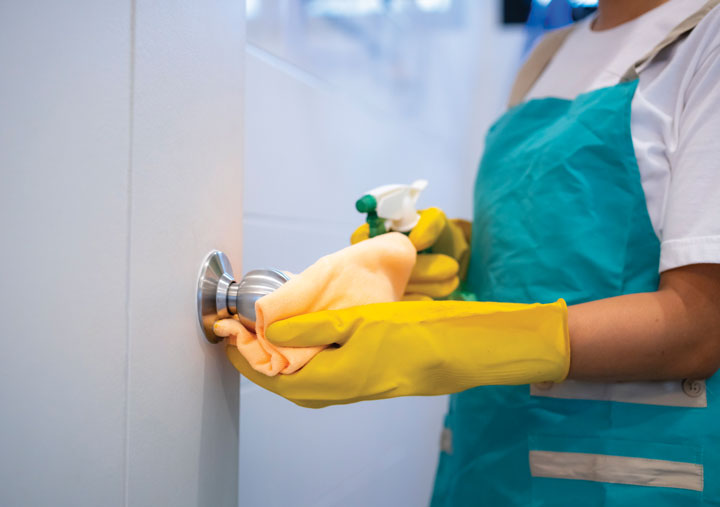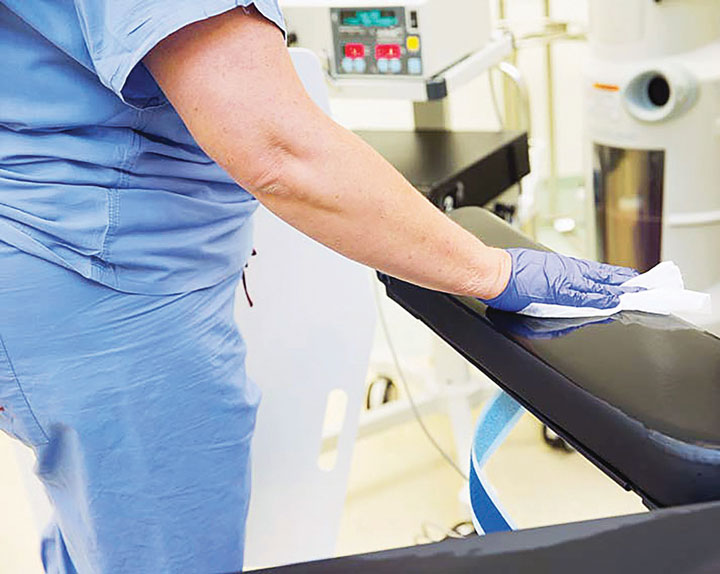Confront Difficult Conversations Head On
Transitioning from a perioperative nurse to a leadership role in an Ambulatory Surgery Center (ASC) presented me with numerous challenges, but none were as daunting...
This website uses cookies. to enhance your browsing experience, serve personalized ads or content, and analyze our traffic. By clicking “Accept & Close”, you consent to our use of cookies. Read our Privacy Policy to learn more.
By: Adam Taylor | Managing Editor
Published: 4/25/2024
The puzzle of superior surface disinfection is never solved. Some facilities continue to commit avoidable errors in their cleaning practices; while others are still trying to shake the notion that every square inch of an OR must be disinfected instead of prioritizing what’s most important.
Leadership sometimes assumes staff knows how to properly disinfect, so proper techniques are given short shrift during the onboarding period. Inexpensive products are purchased to save money, but the directions aren’t followed for them to be effective.
Most facilities conduct many of their surface cleaning duties appropriately, but there’s always room for improvement. Here are six ideas to fine-tune your game and keep infection rates low.
1. Follow the instructions for use (IFUs). People need to understand that the big thing with low-level disinfection is the manufacturers are the ones that set the requirements for what to use on their particular equipment, says Pamela S. Falk, MPH, CIC, FSHEA, FAPIC, a high-risk infection preventionist at Northside Hospital in Atlanta.
“It seems so elementary, but people always want to take shortcuts. They need to follow those IFUs and make sure everybody knows what that means,” says Ms. Falk. “When accreditation agencies come in and ask how you clean your new OR table, you can’t just say you use bleach. You have to say what’s in the IFU and that you follow it.”
Many facilities don’t understand the importance of following IFUs, despite being told so repeatedly, says Ms. Falk, who also runs an infection control consulting business. When IFUs for a new product aren’t clear, it’s important to call the manufacturer for clarification — and get their answers in writing. “Don’t ever just take a salesman’s verbal recommendation and move forward,” she says. “This is really the prime takeaway message on this topic: When performing low-level disinfection on your equipment, you must do it according to the IFUs.”
2. Conduct a risk assessment. A primary reason for following IFUs is to avoid liability if something breaks down or goes wrong. Yet, following multiple IFUs is difficult if they all have different requirements and your OR contains lots of different types of equipment.
A risk assessment can help a facility decide to use one type of disinfectant instead of 10 if one will do the job and create an environment where a single set of instructions are more likely to be followed than 10. The assessment includes a thorough review of all products that could be used.
“I know of a couple places across the country that conducted risk assessments and decided there’s more of a benefit to standardizing their disinfection practices than following multiple IFUs,” says Ms. Falk. “They’re going with one product across the board because they feel it’s effective and easier than trying to use multiple products and not make a mistake.”
Surface disinfection practices are one component of risk assessment templates designed to help facilities determine the quality of their overall infection prevention and control programs, says Association for Professionals in Infection Control and Epidemiology (APIC) President Tania Bubb, PhD, RN, CIC, FAPIC. APIC offers educational webinars about how to perform risk assessments appropriately, and the organization can also connect people with senior infection preventionists for assistance in how to use the template to perform the self-assessments, notes Dr. Bubb.
If the risk assessment leads to the decision to follow all the IFUs, however, someone must create a table or chart that summarizes all of the various instructions, as it’s unlikely time-strapped OR staff or environmental services staff will pore through 10 IFUs, says Ms. Falk, who suggests posting this resource on a wall of each OR.
The CDC also offers a guide for minimum expectations for infection prevention in outpatient settings that can assist facilities.

3. Weigh dwell times vs. price. Some facilities, particularly in rural areas, purchase inexpensive disinfectants to cut costs. They wind up increasing the risk of a patient experiencing an infection that would be more expensive to treat — and potentially litigate — than they could ever save from the lower price of the disinfectant itself.
“Many of the less-expensive disinfectants have 10-minute contact or dwell times to be effective, and it’s not realistic for their staff to follow that rule,” says Ms. Falk. “I don’t know if it’s a lack of knowledge, cost considerations or not placing a sufficiently high value on preventing infection that leads to this decision, but the bottom line is people simply won’t wait 10 minutes before wiping a surface.”
Intermediate-level disinfectants with two- or three-minute recommended dwell times are the way to go. That’s why it’s important to include clinical staff in wipe-purchasing decisions who know how critical it is to follow IFUs and understand professional guidelines on how to use them.
4. Trust but verify. Fluorescent markers are an excellent way to check for gaps in surface cleaning processes. Simply mark high-touch surfaces before a room is cleaned, then use a black or UV light to determine what was cleaned and what was missed. Areas that don’t glow have been cleaned and those that do have not. Technology to test for adenosine triphosphate (ATP) is another useful training tool. Swab an area after a surface is cleaned, put it into a laminator machine and you’ll know how much bacteria remained on the surface.
It’s important to note that ATP testing is an educational opportunity, not a punitive measure, says Marie H. Wilson, MSN, RN, CIC, FAPIC, chair of the APIC Communications Committee and an infection preventionist at Fred Hutchinson Cancer Center in Seattle. “I like to see processes like this involve the staff in a positive and encouraging manner,” she says. “This is not a time for shame.”
Everyone should look at problems together to find solutions. For example, if the patient headwall area is likely to stay contaminated despite the past team’s best efforts, instructors and staff should wipe the area together and watch the ATP reading come up together, says Ms. Wilson. Soon thereafter, the results should improve because everyone is paying more attention to that area.
From there, go into an OR and let the people who do the cleaning identify what else might be getting missed. “You’ll find that someone will point out something that might not be getting cleaned well,” says Ms. Wilson. “Verify it for a few weeks, and then find ways to improved how it’s cleaned, always with a light of positivity shining on it. Results improve when people are motivated to do a really good job.”

5. Training and onboarding. Facility leaders often assume new staff know how to clean and disinfect. After all, everyone cleans and wipes down surfaces at home, right? In reality, cleaning ORs and pre-op and PACU bays is trickier. “Surface disinfection is a practiced art,” notes Dr. Bubb. Ms. Wilson agrees: “There are some really specific techniques to creating a clean OR environment, such as moving from clean to dirty areas, which can be a concept not everyone practices at home, where they might start with the dirtiest thing.”
Training sessions should explain that the cleanest sections should always stay as clean as possible, so you certainly don’t want to use the same rag or wipe that was used on a dirtier surface. Rags and wipes should be replaced often when they’re soiled, and staff should be educated on how many they’ll need for each surface. While a pen you gave to a patient obviously only needs one wipe, an OR table might need two or three.
“Make sure sufficient time and energy is given to teaching proper disinfection procedures and competency validation of them,” says Ms. Wilson. “We shouldn’t be in a rush to onboard new employees. The thought is that we’ve got to get them productive as soon as possible, but not educating staff about best practices is a semi-productive process.”
Ms. Falk notes that The Joint Commission and other visiting agencies generally ask for training records of environmental services techs and members of the OR team who do the cleaning, so it’s important to document everything that’s been done.
6. Prioritize what you clean. A successful surface disinfection risk assessment determines what has the highest potential for contamination. Depending on the facility, it could be splash and spray from the procedure or the hands of OR staff during the surgery.
Ms. Wilson says OR teams are stressed from the mentality that everything in the room needs to be disinfected and that the entire room needs to be sterile, which is a leftover idea from the peak-COVID era. “When we step back and look at the actual risk of transmission, that’s not actually the case,” she says. “Yes, everything needs to be cleaned and dusted, but the focus in a fast-paced world of surgery where high turnover is emphasized needs to be on the greatest risks for infection.”
Having an outside observer watch cases could shed light on the fact that a handle of a device was touched 30 times, but the person who used it didn’t realize it was that frequent and could have been inadvertently contaminated.
“We want to focus on cleaning the most important things,” says Ms. Wilson. “We don’t want to pay more attention to handles of drawers that don’t get touched while not focusing enough on the bed the patient lays on or the handle of the C-arm because it had a cover on it.”
Facilities that still use the types of disinfectants they acquired during COVID — when shortages were prevalent — and didn’t revert to what they used pre-pandemic should reevaluate their options to make sure they are employing the best products that won’t harm their equipment but still kill pathogens of concern.
The practiced art to which Dr. Bubb refers includes following specific IFUs, choosing the proper disinfectants and training staff in a collaborative manner. “It’s about putting the pieces together and working through everything to find the best process for your organization for being consistently competent in disinfection,” she says. OSM
Transitioning from a perioperative nurse to a leadership role in an Ambulatory Surgery Center (ASC) presented me with numerous challenges, but none were as daunting...
Welcome to A Day in the Life of an Administrator, our online column, where we sat down with Cynthia Wiersema, director of nursing at NANI Vascular in Fort Wayne, Ind...
Each of your staff members has a unique personality....